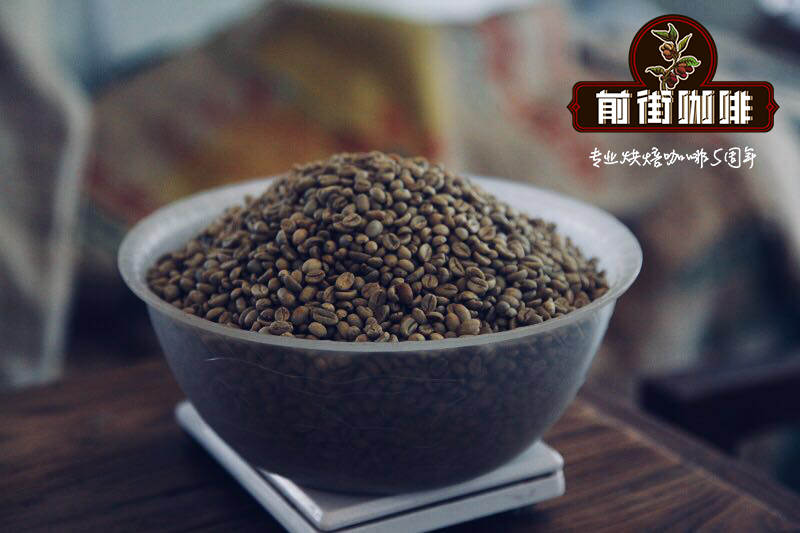Read African, American, Asian specialty coffee beans flavor characteristics Coffee beans flavor differences

Professional coffee knowledge exchange more coffee bean information please follow the coffee workshop (Wechat official account cafe_style)
The flavor of coffee bothers many students. How can I not drink so many flavors on the flavor table? ~ after all, not everyone has professional feelings, or I drink not peach flavor, but plum flavor. The reason for this difference is the different regions of cultural life and diet, different descriptions of the same cup of coffee, so coffee taste, the most important thing is communication. Talk about how you feel about this bean, experience is different, description must be different, but this kind of communication can bring a lot of fun, isn't it? While through theoretical study, drink coffee, feel more, coffee tasting | smell, taste, aftertaste three steps to teach you to taste coffee.
Today, we can clearly understand the flavor characteristics of high-quality coffee beans in Africa, America and Asia through several kinds of coffee products:
The producing areas of coffee beans are mainly divided into Africa, Central and South America and Asia.
Coffee trees are only suitable for growing in the tropics or subtropics, so the zone between 25 degrees north and south latitudes is the most suitable for growing coffee. This coffee production zone is generally referred to as "coffee belt" or "coffee area". The ideal planting conditions of coffee trees are as follows: the temperature is between 15 ℃ and 25 ℃, and the annual rainfall must reach 1500mm~2000mm. At the same time, the rainfall time should be matched with the flowering cycle of coffee trees.
Of course, in addition to the coordination of seasons and rainfall, there should also be fertile soil. The most suitable soil for growing coffee should be fertile soil that is well drained and contains volcanic ash.
Coffee beans from three continents have their own characteristics. to put it simply, [African beans] have a rich flavor of tropical fruits, and [American beans] have a balanced flavor and taste, not only soft fruit acid, but also nuts and cocoa flavors. [Asian beans] prefer high-quality herbs, spices and caramel, with a thick texture.
Flavor characteristics: charming acidity
African bean flavor: Ethiopian coffee has a strong orange flavor, while Kenya coffee has strong raspberry aromas, sour aromas of black plum juice and grapefruit, and sweet sugarcane aromas. The orange aroma of Ethiopian coffee and the raspberry flavor of Kenyan coffee are the most important features of African beans, and they are also the most attractive to coffee fans.
African coffee is generally characterized by strong aroma and charming acidity, its sour brightness is lively and exhilarating, but African coffee is often slightly thin and not very sweet. African coffee due to drought and lack of water, mostly use the sun method to deal with raw beans, the bean shape is often uneven and beautiful, and the defect rate is high.
Representatives of the African series:
[Sidamo Sunshine]
In the Xidamohanbela producing area, the more famous bean representative [Sakuran] is also quite outstanding. Humbera is located in GUJI, the largest coffee producing region in Ethiopia, and the administration is subordinate to the state of Oromia. The west of Hambella is across the mountain from kochore. The two producing areas are separated by highlands with an elevation of 3200 meters and a width of about 30 kilometers, and are connected with the shakiso,Uraga and Kerchaz producing areas of Guji in the east and south, respectively. It is the highest coffee producing area in Ethiopia (Harrar is the main producing area in Ethiopia). Of all these estates and processing plants, only the sun-tanned coffee from the "BukuAbel" manor and processing plant is called "Sakuran". Buku Abel is a small village surrounded by mountains on the African continent at an altitude of 2280 meters.
Qianjie Coffee newly entered the 2018 new production season Essehuakui, from the core production area of Hambella, Shanquan processing plant micro-batch. December is the coffee harvest season in a small village surrounded by mountains 2280 meters above sea level. at this time, the mountains are covered with red and ripe coffee fruits, and the village is neatly arranged on African tanning beds. This is where Sakuran deals with it.
Most of the coffee estates in Ethiopia are still in the original state, and the varieties are native species, and the local farmers just go to the mountains to pick them. The red-brown organic soil, the average annual rainfall exceeds 1200mm, the altitude, and the temperature difference between day and night. Sakui only chooses all red fruits, fully ripe coffee cherries, and all manual picking. The continental scaffolding is dried, the thickness of the fruit layer is limited and turned regularly for 24 hours, and the manor is fermented at low temperature in the unique natural environment.
In the harvest and treatment season (December-January), its unique growth environment and natural climate created the unique flavor of Huakui. The sugar content of the red fructose we are picking is more than 30 before we start the exquisite sun treatment. In the first two days of the sun, it is necessary to ensure the humidity of the red fruit so that its fructose fully begins to ferment. The temperature of the treatment plant can drop to about 12 degrees Celsius at night. at night, in order to prevent sudden rain, the red fruit will be wrapped in thick plastic sheeting to ferment and dehydrate the red fruit at a relatively low temperature. When the temperature is relatively high at noon, it will be shielded from sunburn. After 18 days of sun treatment, when the moisture content of raw coffee beans is reduced to about 13%, stop sun treatment, put it in sacks, put it in the warehouse under natural conditions of 12-22 degrees Celsius and 40-50% humidity, raise raw beans and further dehydrate for about 50 days.
Flavor: it has obvious aromas of cantaloupe and fermented wine, strawberry jam, soft acidity on the palate like jackfruit, berry flavor of middle strawberries and some sugar.
[Kenya Sika AA]
Kenya is a famous coffee producing country in East Africa, and the coffee producing areas are mainly concentrated in the plateau areas represented by Mount Mt.Kenya. Tropical climate, acid red volcanic soil provides a natural and suitable growth environment for coffee, about 1550m above sea level. It is most famous for seven major producing areas, including Neri, Sika, Chiambu, Geliniya, Ruiru, Mulanga and the western side of Mount Kenya, with the main producing areas such as Nyeri and Ruiru in the middle. The tropical climate and acid red volcanic soil provide a natural and suitable growth environment for coffee.
Two varieties, SL-28 and SL-34, are mainly grown, and they are the most respected varieties produced by Scott Laboratory in Kenya in the 1930s. The Scott Laboratory no longer exists, but it is now the National Agricultural Laboratory and part of the Kenyan Agricultural and Animal Husbandry Research Organization. Both varieties are derived from bourbon. SL-28 was developed from drought-resistant varieties originally grown in Tanganyika, part of modern Tanzania, which is generally considered to be of the highest quality but has a low yield compared to other commercial Arabica varieties. SL-34 is a variety originally found near Kabete and performs well at low elevations. Both SL variants showed bronze tender leaves.
In terms of treatment, water washing is a cyclic repeated treatment after fermentation. On the day of harvest, the best quality coffee cherries are selected, peeled and fermented. The fermentation time is 24 hours, and then washed with clean river water 24 hours later. Then, it is fermented again with clean river water for 24 hours, and then washed, so it is repeated 3 times for 72 hours, so it is called Kenyan 72-hour fermentation water washing treatment, referred to as K72. This treatment allows coffee beans to ferment for a long time at low temperature, so that beans can have a brighter, cleaner but full flavor!
Flavor: wet aroma with ripe tomato and flower aromas, imported virgin fruit and black plum flavor, bright acidity, clean taste, medium texture, outstanding middle sweetness, juicy, raspberry and yellow sugar on the finish, and green tea aroma.
Central and South America
Characteristics of taste: balanced, moderate acidity and mellow taste
The flavor of Central and South American beans: generally speaking, the flavor is relatively regular. Costa Rican coffee is gentle and supple, well balanced with a blend of sour, sweet and chocolate aromas.
The overall flavor of Latin American coffee is famous for its balance, and all the flavors in Latin American coffee can be found in Latin American coffee. Good processing also makes its beans larger and more uniform than African coffee, with a lower defect rate.
Representatives of the Americas series:
[Costa Rican honey treatment]
Costa Rica is the country where coffee was first introduced into Central America to grow. Because it is located in the Central American Gorge, with many volcanoes and natural advantages of sunshine and land, it is tempered by Pacific and Atlantic currents and sea breezes at the same time. The coffee produced has the characteristics of local micro-climate. The earliest planting sites were located on the slopes of the Poas and Barva volcanoes, today known as the Central Valley. After years of development, Costa Rica has eight main producing areas, namely: Guanacastes, West Valley, Central Valley, Turrialba, Orosi, Tres Rios, Tarrazu and Brunca.
Honey treatment, called HoneyProcess, refers to the process of making raw beans which are sun-dried with mucous membrane. Take the juice from the coffee berry treatment to soak the shell bean in the treatment, because the berry juice contains high sweetness and unique enzymes, the processed shell bean contains richer taste and very complex positive flavor!
The more pectin is retained, the richer the flavor and sweetness of the coffee will be. The pectin mucous membrane is the part with the highest content of coffee fructose, and it is also an important part of coffee fermentation. It can be said that 80% of this part determines the nutritional supply during the treatment. Yellow honey retains 60% pectin, red honey retains 75% pectin, and black honey hardly removes pectin. From the sugar and acid content of the pectin layer, during the drying period, the sugar in the pectin layer will become more and more concentrated, and the sugar will soak into the coffee beans.
Kaddura is mainly planted, with a sour taste of lemon or citrus, but not as sweet as iron pickup and bourbon in terms of sweetness, because Kaddura's sweetness depends on the number and dose of fertilizer applied by the grower, and has high production capacity. however, in order to maintain capacity, continuous fertilization and pruning are required, so the trees are short and branched. Although production capacity has increased, production is still limited because of the two-year harvest period and the high cost of care.
Flavor: floral and creamy aromas, lemon, Brin, sweet orange, peach flavor, grapefruit, juice, natural sweetness, meticulous taste, perfect and balanced as a whole.
[Guatemala Miracle Villa]
The characteristics of ● taste: bitter and fragrant, good taste.
Guatemalan coffee grows in high-altitude cloud belts, and the climate conditions such as the large temperature difference between morning and evening make the coffee not grow too fast. Vivette Nanguo Highland, a place name with temperament, is located in the northwest of Guatemala. the soil of the highland is fertile and rainfall is abundant, and the cloud belt generated by the unique valley terrain of the high platform is the best coffee growing environment given by God. Therefore, Vivette South Fruit Highland is famous for producing high-quality coffee. Most of the winning beans in the Guatemalan coffee competition come from Vivette South Fruit Highland, which has a very good evaluation in the international community.
Miraculous Villa grows in this area and has fertile volcanic soil, volcanic ash has a moisturizing effect, retains sufficient moisture and temperature, protects the area's coffee from frost, and is characterized by delicate citrus acid in taste.
In the method of treatment, the method of washing first and then drying is adopted. after harvest, it is put into a storage tank to remove sundries and immature beans, then put into a peeling machine to remove the pulp and peel, put into a fermentation tank to decompose the pectin that remains in the inner pericarp, put it into a washing pool, remove pectin, and get raw beans with endocarp, and finally put them into a sun-drying field or dryer for sun drying.
Most of the plants are bourbon, Kaddura and Kaduai, which have a great sense of sweetness, balance and complex flavor.
Flavor: the sweet and sour feeling is obvious and soft, with rich chocolate and nutty flavor, obvious tea feeling, slight smoky taste in the back, soft acidity, high plugging and high cleanliness.
Asian coffee
Characteristics of taste: deep flavor and strong taste
Asian beans and island flavor: mellow thickness is higher than Central and South American beans and African beans, but the sour taste is lower, the flavor is slightly sunken wood, herbs, spices and soil, and the low stuffy aroma is higher than the rising sour flavor. Island beans are relatively light and gentle, with a light and elegant tone.
Representatives of the Asian series:
[Lin Dong Manning]
The main producing areas of Indonesian coffee are Sumatra, Java and Sulawesi, of which "Manning" from Sumatra is the most famous. At the north end, Lake Tawa can be called Aceh Coffee or Lake Tawa Coffee, and the area between Lindong and Lake Toba can be called Manning. There are eight provinces, but only two provinces grow a lot of coffee-Aceh and Jiangsu, the two most representative coffee producing areas are the Gayo Mountains around Lake LakeTawar in Aceh, which are grown by indigenous Gayo people.
Coffee in Jiangsu Province is grown around Lake Lake Toba, which covers a huge area and is the largest volcanic lake in the world. Mantenin, produced by Lake Tawa and Lake Tawa, is the famous "two lakes and two man", while to the south of Lake Toba is the Lintong producing area.
Lin Dong Mantenin grows on the plateau and mountains at an altitude of 1000-1500 meters above sea level. There are many volcanoes and many volcanic lakes in its territory, of which the most famous coffee growing area is located in the freshwater lake Lake Lawar. Fresh soil, which comes from volcanic soil, is a primitive brown ash mixed with a considerable amount of organic matter. Coupled with the local rainforest climate, Rain Water is abundant all the year round, providing the most suitable geographical and climatic environment for coffee growth.
The treatment method is commonly used [wet planing], which makes the flavor mellow and strong, and the personality is very distinct. Because the humidity in Indonesia is between 70-90% all year round and there are frequent typhoons, it is necessary to speed up the drying efficiency of coffee fruits in such a humid climate. First of all, remove the skin and pulp, retain the parchment and mucous membrane to ferment in the pool, then wash the mucous membrane, dry the parchment in the sun for 2-3 days, until the water content is 20-24%, planing the parchment will remove the parchment, and the sun will shine directly on the surface of the raw bean, making the coffee raw bean dry quickly, which is 2-3 times faster than the washing treatment. So beans are more likely to be squeezed and form a small gap, which is what we often call horseshoes or sheep's hoof beans.
Flavor: sweet herbs, cinnamon spices, full-bodied sweetness, caramel, cream, walnut, chocolate. The acidity is steady and soft, with rich melon aromas, a touch of spices and a mellow herb flavor.
Related recommendation: is hand-made coffee really good? Why does coffee smell better than it tastes?
Important Notice :
前街咖啡 FrontStreet Coffee has moved to new addredd:
FrontStreet Coffee Address: 315,Donghua East Road,GuangZhou
Tel:020 38364473
- Prev

How long will it take for coffee beans to expire? How should I drink expired coffee beans?
Professional coffee knowledge exchange more information about coffee beans Please pay attention to the coffee workshop (Wechat official account cafe_style) Coffee is a crop and, like other foods, it can rot. I believe many people may have a question: how long will it take for coffee to be out of date? There are two ways to explain this question: one is, when will my coffee exceed the peak of the best drink? (also
- Next

How to distinguish the sweetness in coffee How to brew and taste the sweetness in coffee Coffee has
Professional coffee knowledge exchange More coffee bean information Please pay attention to coffee workshop (Weixin Official Accounts cafe_style) Today Xiaobian to talk to you about the taste sweetness of coffee senses First let's look at what is sweet? The commonly accepted definition of sweetness is that it is the taste produced by the high sugar content of food. The most common is a lot of sweet substances, carbohydrates. this
Related
- Beginners will see the "Coffee pull flower" guide!
- What is the difference between ice blog purified milk and ordinary milk coffee?
- Why is the Philippines the largest producer of crops in Liberia?
- For coffee extraction, should the fine powder be retained?
- How does extracted espresso fill pressed powder? How much strength does it take to press the powder?
- How to make jasmine cold extract coffee? Is the jasmine + latte good?
- Will this little toy really make the coffee taste better? How does Lily Drip affect coffee extraction?
- Will the action of slapping the filter cup also affect coffee extraction?
- What's the difference between powder-to-water ratio and powder-to-liquid ratio?
- What is the Ethiopian local species? What does it have to do with Heirloom native species?

